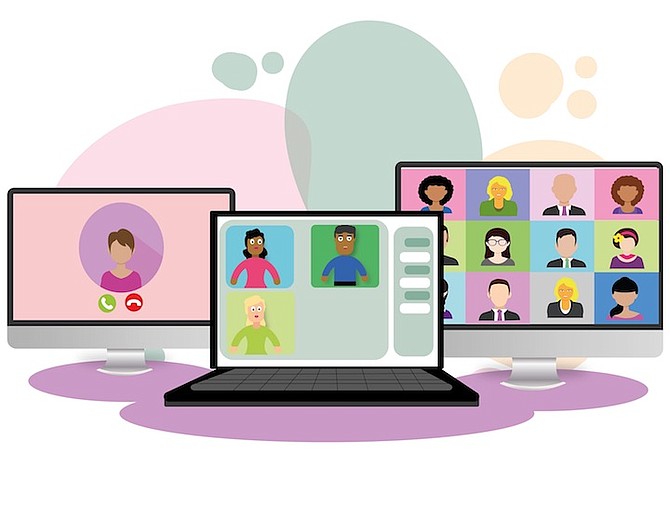WE have all attended far too many Zoom events over the past few years due to the COVID-19 pandemic.
From meetings and workshops to birthday parties and weddings, many people have had to figure out new ways to host events. As with in-person events, there is a significant amount of planning and management that goes into a successful virtual event.
Unfortunately, it seems it is often assumed virtual events are easy, and any in-person event can be made virtual simply by setting up a Zoom session or using another online platform. This is one reason many online events do not have the effect the organizers or attendees expect.
When planning a virtual or hybrid event, it is important to choose the right platforms, tools and teams. The purpose of the event and expected participants should help to guide the decision-making and event-planning process. It is not enough to set up a smart phone on a tripod, post the link and hope for the best.
There are ways to host an event that meets most people’s needs and facilitates productive, meaningful engagement. Here are eight tips to get you started.
• Share the options. If you are hosting a hybrid event, ensure potential participants are aware of the options available to them. Some people may want to attend in person. As there is a limit to the number of people who can gather in a physical space, make the restrictions clear. Do people need to register by a certain date? Should they expect confirmation that they can attend in person by a certain date? Will there be an overflow room on site for those who do not fit into the main venue? For those who prefer not to attend in person, do they need to download an app or register on a particular website to gain access? Is it available on both Apple and Android devices? For those without internet access, will it be available on television or radio? Can people watch live on a social media platform? For some, it is easiest to watch on Facebook while others would prefer to be on a platform that makes it easier to interact with other attendees. If there are multiple points of access, let everyone know whether or not they can expect direct engagement or for any comments they make to be read, considered, and/or shared with others.
• Test the internet connection. When streaming an event, be sure your internet connection is stable. Especially if you are using an unfamiliar venue, test the internet connection. Ensure you can launch the platform you plan to use for the stream, set up a test link, and ask colleagues to log in. Test the sound in the room, cameras, clarity of any media played in the room, and angles for the camera(s) you will use. Connect multiple devices in the room and test the internet connection on each one. Test the limits and put back-up plans in place.
• Set appropriate security settings. Complete a risk assessment and determine your security needs. Most platforms for virtual events have options for the host to control people entering the room and/or a password option to help you ensure only the people invited or registered are able to join. You can also disable videos and microphones or have them automatically turned off upon entry to minimise disruption of the event.
• Prioritise accessibility. If you were not thinking about accessibility before, now is the best time to start. Ensure the faces of the speakers are on the screen to help people who read lips. Make the sign language interpreter visible. Ahead of the event, you will need to set up the interpreters and at the start of the event, you need to let participants know how they can access interpretation in each language. Enable live transcription and close captioning. Do everything you can to make your event accessible to people with disabilities. This includes requiring the use of a microphone by people in the physical meeting room. People often insist they are loud enough. This is not true, and they need to be corrected and directed to use the microphone. The microphone increases accessibility to people in the room and those attending online.
• Set guidelines for participation. At the beginning of the event, set the stage and set expectations. Let everyone, in-person and online, know how the event will be managed, who is available to offer assistance, and when and how they will be able to engage. Can they unmute themselves? Should they use the chat feature? Do they need to turn their videos on? Do they need to share their names and affiliations when they speak and, if so, why? Will anonymous contributions be accommodated? If so, how, and if not, why not? If there will be breakout rooms online, take the time to explain how participants get to the correct rooms and what is supposed to happen when they get there. When there are different activities taking place in-person than online, this needs to be explained and the online participants need to be made aware. Be especially careful to announce the times of all breaks and use the chat to let online participants know when breaks start and when the session is expected to resume. This is especially helpful for people who may step away from the session and miss the announcement.
• Provide relevant documents in advance. What do people need in order to fully participate in your event? Think of all of the documents you will reference and the questions you will ask them to consider. Imagine what you would put in a registration pack. Some of it is probably unnecessary, so focus on the parts that they will search for as people present or flip through and write on during group sessions. If there is no real reason to wait until the moment you reference them during the event to share them, make them available at the time of registration or confirmation. Give people time to read and annotate documents. Give them the opportunity to increase the text size and print it out. Remember that everyone is not able to absorb new information quickly or work with multiple documents while paying attention to a presentation. Send the documents in advance.
• Assign someone to provide technical support. Someone has to be online throughout the event, solely focused on the platform. This person needs to respond to people who are typing into the chat that they cannot hear anything. They need to contact the technical team in the physical space to let them know the slides are not visible online. They need to quickly eject anyone who is sending inappropriate messages from the room. This person is always watching, knows who to call for what, and is quick to act.
• Get permission to record and/or stream. It is now common for organisers to record and stream their online and hybrid events. For those who attend these kinds of events frequently, it is almost expected, but everyone does not know this. Regardless, it is necessary to obtain consent. If you intend to record or stream your event, ensure this is made clear. Reiterate it at times when it is especially relevant such as question and answer periods. Where possible, provide an opportunity for people to contribute anonymously and/or pause the recording. If chat messages are being saved, this information also needs to be provided to online participants. Ensure everyone knows if and when their contributions are being shared with the public.
This is, of course, not an exhaustive list of recommendations. It is a place to start. One of the best ways to ensure you meet people’s needs is to ask them to share those needs with you. Certain times of day or days of the week may be better than others. One social media platform may be more accessible than others. Anonymity may be important to some people. Others may want to ensure they have the same opportunity to speak as the people in the physical meeting room. Once you know their needs, consider them alongside the purpose of your event and ask for help. To do it well, you will need support, and the sooner that team is in place, the better for everyone. Don’t try to do it the quick and easy way. Put in the extra effort to make it a positive experience for everyone, and don’t forget to ask for feedback to help you make the next one even better.






Comments
Use the comment form below to begin a discussion about this content.
Sign in to comment
Or login with:
OpenID